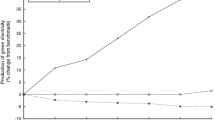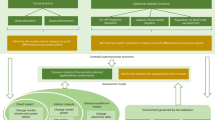Abstract
The paper analyzes the relationship between CO2 mitigation policy and promotion policies designed to deploy renewable energy sources for electricity production (RES-E). If an emission cap is the only policy target, an optimal mix consisting of high and low carbon use of fossil fuels, deployment of RES-E, and energy savings can best be achieved by either setting a uniform carbon tax or by implementing a cap-and-trade system covering all CO2 sources. An additional RES-E share target causes higher costs in achieving the cap. Conversely, a more ambitious emission target automatically increases the RES-E share. In a second step, we investigate different policies for inducing an RES-E quota. Such a quota can be efficiently achieved either by a system of tradable green certificates, budget-balanced FIT system, or budget-balancing premium system. We also show that differentiated, technology-specific FITs are not efficient.



Similar content being viewed by others
Notes
For details, see Selin and VanDeever (2009).
In Germany, the FIT mark-up was 3.59€ cents per kwh in 2012. By 2014 the mark-up increases by 47 % to 6.27€ cents per kwh. (http://www.bmwi.de). If the still low share of off-shore wind power capacity is further increased, an additional sharp increase in the mark-up is likely to occur.
An institutional setting of this kind is used in Germany, for example. It is also possible to pay a tariff in addition to the market price (premium model), as is the case in Spain. In the absence of uncertainty, these two regimes are equivalent. The premium naturally differs in size from the FIT.
According to Savin et al. (2012), 65 countries world-wide use FITs, while 18 countries (53 jurisdictions) use quotas or renewable portfolio standards, the less efficient version of a tradable quota system.
Introduction to DIRECTIVE 2009/28/EC (EC (2009)), paragraph (1).
Ibid. paragraph (3).
Ibid., paragraph (4).
Here, we observe a 200 % real price increase over the last 12 years (InvestmentMine (2013) and own calculations).
The share of oil in electricity production is 5 % worldwide and 3 % in the EU.
Especially magnets for modern wind turbines use large amounts of Nd. Batteries, catalytic converters, and other so-called environmental technologies often require up to a dozen different rare earth elements.
Detailed calculations of all values can be obtained from the author on request.
References
Abbasi SA, Abbasi N (2000) The likely adverse environmental impacts of renewable energy sources. Appl Energy 65:121–144
Acemoglu D, Aghion P, Bursztyn L, Hemous D (2012) The Environment and Directed Technical Change. Am Econ Rev 102(1):131–166
Aghion P, Howitt P (1998) Endogenous growth theory. MIT-Press, Cambridge
Auer H, Resch G, Haas R, Ragwitz M (2009) Regulatory instruments to deliver the full potential of renewable energy sources efficiently. Eur Rev Energy Markets 3:91–124
Bläsi A, Requate T (2009) Feed-in-tariffs for electricity from renewable energy resources to move down the learning curve? Public Finance Manage 10(2):213–250
BMU (2012) German Federal Department for the Environment, habitat protection, and nuclear power security. http://www.bmu.de/service/publikationen/downloads/details/artikel/erneuerbare-energien-gesetz-eeg-2012/
Böhringer C, Rivers NJ, Rutherford T, Wigle R (2012) Green Jobs and renewable energy policies: employment impacts of Ontario’s Feed-in Tariff. BE J Eco Anal Policy 12, Article 25, doi:10.1515/1935-1682.3217
Böhringer C, Keller A, van der Warf E (2013) Are green hopes too rosy? Employment and welfare impacts of renewable energy promotion. Energy Econ 36:277–285
Burger B (2012) Electricity Production from solar and wind in Germany. Fraunhofer Institute for solar energy systems ISE. http://www.ise.fraunhofer.de/en/downloads-english/pdf-files-english/news20/electricity production from solar and wind in germany 2012.pdf
CNE (2013) Liquidación de las primas equivalentes, primas, incentivos y complementos a las instalaciones de producción de energía eléctrica en régimen especial mes de producción: 12/2012, Comisión Nacional de Energía, dirección de inspección, liquidaciones y compensaciones, February 2, 2013
EC (2009) Directive 2009/28/EC of the European Parliament and of the Council of 23 April 2009 on the promotion of the use of energy from renewable sources and amending and subsequently repealing Directives 2001/77/EC and 2003/30/EC
Haas R, Eichhammer W, Huber C, Langniss O, Lorenzoni A, Madlener R, Menateau P, Morthorst P, Martins A, Oniszek A, Schleich J, Smith A, Vass Z, Verbruggen A (2004) How to promote renewable energy systems successfully and effectively. Energy Policy 32:833–839
Haas R, Resch G, Panzer C, Busch S, Ragwitz M, Held A (2010) Efficiency and effectiveness of promotion systems for electricity generation from renewable energy sources—Lessons from EU countries. Energy. http://public.tuwien.ac.at/files/PubDat_193135.pdf
Held A, Haas R, Ragwitz M (2006) On the success of policy strategies for the promotion of electricity from renewable energy sources in the EU. Energy Environ 17:849–868
InvestmentMine (2013) http://www.infomine.com/investment/metal-prices/coal/. Accessed 15 Dec 2014
Jensen SG, Skytte K (2002) Interaction between the power and green certificate markets. Energy Policy 30:425–435
Klessmann C, Nabe C, Burges K (2008) Pros and cons of exposing renewables to electricity market risks—a comparison of the market integration approaches in Germany, Spain and the UK. Energy Policy 36:3646–3661
Madlener R, Gao W, Neustadt I, Zweifel P (2009) Promoting renewable electricity generation in imperfect markets: price vs. quantity policies. University of Zurich Socioeconomic Institute, Working Paper 0809
Menanteau P, Finon D, Lamy ML (2003) Prices versus quantities: choosing policies for promoting the development of renewable energy. Energy Policy 31:799–812
Midttun A, Gautesen K (2007) Feed in or certificates, competition or complementary? Combining a static efficiency and a dynamic innovation perspective on the greening of the energy industry. Energy Policy 35:1419–1422
Mitchell C, Bauknecht D, Connor PM (2006) Effectiveness through risk reduction: a comparison of the renewable obligation in England and Wales and the feed-in system in Germany. Energy Policy 34:297–308
Morthorst PE (2003a) National environmental targets and international emission reductions instruments. Energy Policy 31:73–83
Morthorst PE (2003b) A green certificate market combined with liberalized power market. Energy Policy 31:1393–1402
Nemet G (2006) Beyond the learning curve: factors influencing cost reductions in photovoltaics. Energy Policy 34:3218–3232
Petrakis E, Rasmusen E, Roy E (1997) The learning curve in a competitive industry. Rand J Econ 28:248–268
Reichenbach J, Requate T (2012) Subsidies for Renewable Energies in the Presence of Learning Effects and Market Power. Resour Energy Econ 34:236–254
Savin JL (lead author) et al. (2012) Renewables 2012. Global status report. REN21 secretariat Paris
Schmalensee R (2012) Evaluating policies to increase electricity generation from renewable energy. Rev Environ Eco Policy 6:45–64
Selin H, VanDeever S (2009) Changing climates in north american politics, institutions, policymaking, and multilevel governance. The MIT Press, Cambridge
Tamas MM, Shrestha SO, Zhou H (2010) Feed-in tariff and tradable green certificate in oligopoly. Energy Policy 38:4040–4047
Tinbergern J (1952) On the theory of economic policy. North-Holland, Amsterdam
Tsoutsos T, Frantzeskaki N, Gekas V (2005) Environmental impacts from solar energy technologies. Energy Policy 33:289–296
US Department of Energy (2012) 2011 wind technology market reports. www1.eere.energy.gov/wind/pdfs/2011_wind_technologies_market_report.pdf. Accessed 15 Dec 2014
Zhou H, Tamas MM (2010) Impacts of integration of production of black and green energy. Energy Economics 32:220–226
Acknowledgments
I am grateful to Christoph Böhringer, Mathis Klepper, Matthias Weitzel, and two anonymous referees for helpful comments, and Stacy VanDeveer for information on overlapping US carbon policies.
Author information
Authors and Affiliations
Corresponding author
Appendix
Appendix
Proof of Proposition 2
Differentiating (7)–(10) with respect to \(\bar{E}\), we can write the resulting equation system in matrix form (omitting the function arguments) as
Let \({\text{Det}}(M) = \left[ {\alpha_{\text{f}}^{2} C_{\text{b}}^{{\prime \prime }} + \alpha_{\text{b}}^{ 2} C_{f}^{{\prime \prime }} } \right]\left[ {C_{\text{r}}^{{\prime \prime }} - P^{{\prime }} } \right] - C_{\text{r}}^{{\prime \prime }} P^{{\prime }} \left[ {\alpha_{\text{b}} - \alpha_{\text{f}} } \right]^{2} > 0\) be the determinant of the matrix in (62). Solving (62), we obtain
While (64) is ambiguous as to the sign, we see immediately by adding (63) and (64) that
Finally, for the share of renewable energy we obtain
That the sign of \(\frac{{{\text{d}}Q_{\text{f}} }}{{{\text{d}}\bar{E}}}\) is indeed ambiguous can be shown by example. Choose \(P(Q) = A - BQ\) and \(C_{i} (Q_{i} ) = \frac{{c_{i} }}{2}Q_{i}^{2}\) and let A = 100.0, B = 1.0, c b = 0.1, c f = 0.3, c r = 1.0, α b = 1.0, α f = 0.5. If we now tighten the emission cap from \(\bar{E} = 50\) to \(\bar{E} = 40\), we will find that Q f increases from 16.67 to 37.78. If we choose c f = 0.9, keeping all other parameters as before and tightening the emission cap from \(\bar{E} = 50\) to \(\bar{E} = 40\), we will find that Q f decreases from 18.13 to 17.10.Footnote 14
Proof of Proposition 3
Differentiating (12)–(14) with respect to ζ yields in matrix form
Let \({\text{Det}}(M) = C_{\text{r}}^{{\prime \prime }} \left[ {C_{\text{b}}^{{\prime \prime }} C_{\text{r}}^{{\prime \prime }} - P^{{\prime }} (C_{\text{b}}^{{\prime \prime }} + C_{\text{f}}^{{\prime \prime }} )} \right] > 0\) be the determinant of the matrix in (69). Solving this equation, we obtain
From this we derive, after simplification,
Proof of Proposition 4
Differentiating (17)–(20) with respect to \(\zeta\) yields in matrix form
By stability of the competitive equilibrium the determinant of the matrix \({\text{Det}}(M) = C_{\text{r}}^{{\prime \prime }} \left[ {\left[ {C_{\text{f}}^{{\prime \prime }} + C_{\text{b}}^{{\prime \prime }} } \right]\left[ { - P^{{\prime }} \; \times \;Q - t} \right] + C_{\text{f}}^{{\prime \prime }} C_{\text{b}}^{{\prime \prime }} \left[ {Q_{\text{b}} + Q_{\text{f}} } \right]} \right]\) must be positive. Solving (75), we obtain
To show that the sign of \({\text{d}}Q/{\text{d}}\zeta\) is ambiguous, we again choose linear (inverse) demand \(P(Q) = A - BQ\) and cost functions of the type \(C_{j} (q) = c_{j0} q + c_{j1} q^{2} /2\) for j = b, f, r. Parameters are selected according to A = 100.0, B = 1.0, \(c_{b0} = 0.1\), \(c_{b1} = 0.1\), \(c_{f0} = 0.2\), \(c_{f1} = 0.3\), \(c_{r0} = 1.0\), \(c_{r1} = 0.05\).
Then for ζ = 8 (ζ = 10, ζ = 12) we obtain Q = 380 (Q = 385, ζ = 380).
Proof of Proposition 6
By differentiating (26)–(29) with respect to β we can write the resulting equation system in matrix form (omitting the function arguments) as
Writing the determinant of the matrix in (82) as \({\text{Det}}[M] = - C_{\text{b}}^{{\prime \prime }} C_{\text{f}}^{{\prime \prime }} [1 - \beta ]^{2} + \beta^{2} [C_{\text{b}}^{{\prime \prime }} + C_{\text{f}}^{{\prime \prime }} ][P^{{\prime }} - C_{\text{r}}^{{\prime \prime }} ] < 0\) for short and solving (82), we obtain
To show the ambiguity of \(\frac{{{\text{d}}Q_{\text{r}} }}{{{\text{d}}\beta }}\), \(\frac{{{\text{d}}\mu }}{{{\text{d}}\beta }}\), and \(\frac{{{\text{d}}Q}}{{{\text{d}}\beta }}\) we take the functional forms as in the proof of Proposition 2 and choose A = 100.0, B = 1.0, \(c_{b} = 0.1\), \(c_{f} = 0.3\), \(c_{r} = 1.0\). Increasing \(\beta\) leads to strictly increasing Q r, decreasing total output and increasing shadow cost of the RES-E. Taking a less elastic inverse demand function by selecting B = 0.2, we can show Q r and the shadow cost μ to be inverted U-shaped. Choosing B = 1.5, we can see that for small but binding β, total output is first increasing then decreasing when β is increased.
About this article
Cite this article
Requate, T. Green tradable certificates versus feed-in tariffs in the promotion of renewable energy shares. Environ Econ Policy Stud 17, 211–239 (2015). https://doi.org/10.1007/s10018-014-0096-8
Received:
Accepted:
Published:
Issue Date:
DOI: https://doi.org/10.1007/s10018-014-0096-8




